Playing Mimesis: Engendering Understanding Via Experience of Social Discrimination with an Interactive Narrative Game
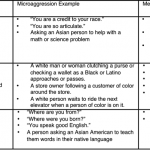
The authors discuss their effort to raise critical awareness about microaggressive racist behavior with Mimesis, an interactive game set in an underwater environment where players become sea creatures, and where they feel the social force of microaggression regardless of the their race or ethnicity.
The authors discuss their effort to raise critical awareness about microaggressive racist behavior with Mimesis, an interactive game set in an underwater environment where players become sea creatures, and where they feel the social force of microaggression regardless of the their race or ethnicity.
“You are so articulate.”
“You are a credit to your race.”
- Sue et al., “Racial Microaggressions in Everyday Life,” p. 276
Racism persists, especially in its more invisible and subtle forms. Terms including modern racism, symbolic racism, and aversive racism, emphasize forms of racial discrimination that are “more likely than ever to be disguised and covert,” in contrast to the more popularly recognized “old-fashioned” varieties of racism characterized by “overt racial hatred” and public displays of bigotry (Sue et al. 271). Microaggression, a term forwarded by Solorzano et al. in critical race theory, represents one of the most succinct distillations of this phenomenon (Solorzano, Ceja, & Yosso, 2000). Describing “brief and commonplace verbal, behavioral, and environmental indignities,” microaggressions are often cloaked in ambiguous language that may even seem partially benign (Sue et al. 273). Furthermore, microaggressions can be perpetrated by people who see themselves as liberal and/or egalitarian (and who would be quite offended by the idea that they hold latent biases). Such qualities make microaggressions a subtle phenomenon, yet one documented by clinical psychologists as being significantly detrimental to people’s health and happiness.1
Awareness of biases, privilege, and oppression is important in understanding and combating the complex phenomenon of microaggressions. Digital media such as video games and social media hold great potential for engendering awareness about these issues.2 However, at present, more work needs to be done to enable digital media to represent complex and subtle identity phenomena in appropriately sensitive and nuanced ways. As a step toward creating rich experiences capable of engendering critical awareness of identity-related issues, we created an interactive narrative game called Mimesis. With Mimesis we aimed to create an aesthetically engaging experience for players that simultaneously helps to catalyze critical awareness about social identity phenomena. In particular, Mimesis enables players to explore identity phenomena associated with the social ill of microaggression – in this case generalized to forms of discrimination not limited to race and ethnicity.
Mimesis
The story of Mimesis takes place in an underwater setting with subtly anthropomorphized sea creatures as characters. The player character (PC) is a mimic octopus, a species of octopus adept at emulating other creatures. The octopus is on a journey that takes it from the dark depths of the ocean to its home in the shallows. Along its way, the octopus encounters a series of sea creatures (non-player characters, or NPCs), whose utterances serve as examples of particular kinds of microaggression. These sea creatures provoke the octopus. The player must choose between different emotional responses to the creatures in order to guide the octopus through a series of short conversations. In this way, the project maps the experience of discrimination onto a game world based on an underwater metaphor.
The types of discrimination the octopus faces on its journey are exemplified by the NPCs’ unsolicited, unwarranted remarks, such as: “I hope you aren’t planning to get into trouble” and “You don’t seem like the typical creature around here” (i.e. the microaggression themes outlined in Sue et al. [276] of assumed criminality and being an alien in one’s own land respectively).
In aggregate, such utterances constitute microaggressive behavior. The player causes the octopus to respond to such utterances by using gestural input such as spreading his or her fingers on a trackpad or touchscreen (“pinching out”) for an open attitude, or “pinching in” for a closed attitude. These attitudes result in different responses being uttered by the player character. Each encounter plays out according to a conversational narrative schema based on sociolinguistic studies of narratives and personal experience.3
Theoretical and Technical Framework for Mimesis
Mimesis draws upon theories of cognitive categorization and computational identity. In particular, we highlight the experience of identity-based social discrimination and stigmatization by constructing virtual avatars whose in-game actions are constrained based on the player’s real-world identity.4 To do this, we first present the player with an introductory sequence to model a player’s prior experience and understanding of social discrimination. We also follow up with a questionnaire so that we can further refine the experience based upon aggregate player data.
Microaggression
Sue et al. describe microaggressive comments as falling into three categories: microassaults, microinsults, and microinvalidations. Microassaults are “explicit racial derogation,” which are meant to intentionally hurt an intended victim through naming-calling or other racial epithets (Sue et al. 274). They also characterize microassaults as similar in operation to “old-fashioned racism,” but add that they are often most likely to take place in private situations and with an added degree of subtlety. Microinsults, on the other hand, are characterized by a degree of rudeness, but often take place under the auspices of unaware perpetrators. One example of this would be a white employer who hired a white employee who then preempts discussion of why a more qualified prospective employee of different ethnicity did not get the job by stating: “I believe the best person should always get the job, regardless of race.” Finally, a microinvalidation is any communication that “excludes, negates, or nullifies the psychological thoughts, feelings, or experiential reality of a person of color.” The classic example of a microinvalidation is a statement of color blindness in the face of blatant racism, such as stating “I don’t see color” or “race isn’t important because we’re all human beings” when faced with a practice such as racial profiling or other forms of prejudice. Although all of these varieties fall under the umbrella of microagressions, they also represent a spectrum or continuum of discriminatory behavior, from overt to covert, intentional to unintentional.
Within these broad categories, particular themes associated with each kind of microaggressive behavior, such as “alien in your own land,” “assumption of criminal status,” and more have been identified (Sue et al. 278). We use Mimesis as a space to explore how these different themes of microagressions could be instantiated in computational narrative form. In particular, after an initial encounter consisting of a generalized set of microinsults to orient the player to the hostile environment, the player encounters sea creatures representing the microaggression themes in Table 1.
Table 1: A subset of microaggression themes from (Sue et al., 2007) that are implemented in Mimesis.
In addition to focusing on a faithful modeling of microaggressive behavior from the perspective of privilege, we also wanted to explore potential responses to microaggressive behavior from the perspective of an individual of color. Thus, a key aim in our creation of Mimesis was to model how reacting to microaggressions often presents an unfortunate Catch-22: engage with the perpetrator and face confusion or defensiveness, or ignore the barb and try to continue? Both of these options cause undue stress in the person experiencing a microaggressive encounter (Sue et al. 279). Instead of advocating for a “correct” mode of response, we focus on engendering awareness and understanding of the phenomenon of microaggression by pointing out the assumptions and mechanisms of categorization that support it.
Some common types of responses to microagressions include:
- oblivious (ignoring the microaggression),
- confused (attempting to figure out if a microaggression occurred),
- suspicious (sitting in anger from self-doubt), and
- aggressive (striking back at the microaggression perpetrator).
The latter three types are derived from existing research in microaggressions.5 To these, we added the “oblivious” type to cover cases in which the recipient is simply unaware of the implications of the exchange at hand or perhaps actively ignores or dismisses them.
Overview of Gameplay
To illustrate the Mimesis gameplay, we outline an example playthrough below. We first describe how the player is introduced to the game through an introductory sequence. We describe how it is used to both orientate the player as well as to allow us to model a player’s understanding prior to engaging with the system. Next, we provide an example of how gameplay proceeds through a sequence of encounters with various NPCs. Finally, we outline how the narrative experience concludes by taking account of the player’s actions and choices throughout the narrative.
Introduction
Upon accessing the application, the player is presented with an introductory cut-scene showing a microaggressive encounter between two undersea creatures. The cut-scene depicts a jellyfish asking an octopus to open a scallop, since the jellyfish assumes that, as a cephalopod, the octopus must be quite intelligent (the octopus’s response is shown in Figure 1).
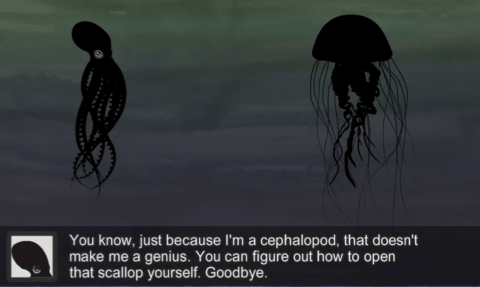
Figure 1: The screen shows the player’s character (left) in a discriminatory encounter in which an NPC (right) metaphorically represents the theme of stereotypical ascription of intelligence/skill (e.g., assuming someone is good at mathematics because of her ethnicity).
Following this, the player is presented with a brief questionnaire about the cut-scene including questions such as: “have you experienced anything like the conversation in the scene you just watched?” and “who was at fault in the scenario depicted in the cut-scene?” The aim of the introductory sequence and following questions is to get a quick snapshot of the player’s knowledge and experience regarding microaggressions. This information is used later to help guide the narrative.
Encounters
The player proceeds to encounter a series of sea creatures. Initially, in the deep sea, the player meets an anglerfish. The NPC initiates the encounter by performing a microinsult, aggressively assuming that it is there, like all of its type, to steal the anglerfish’s mate. The PC then responds based on the user’s gestural input according to one of the four types of response to microaggression, for example in a “confused” manner as is shown in Figure 2.
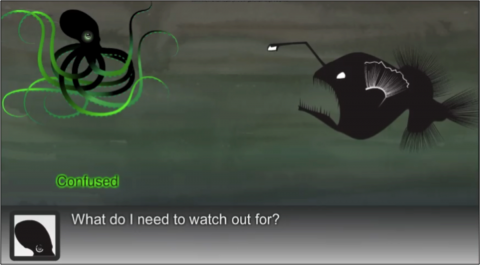
Figure 2. The screen shows the player’s character (left) in a microinvalidation encounter with an NPC. The NPC is green in color due to it exhibiting the “confused” mood.
The game’s visual assets are tied to the four response types identified above, whereby each player character is highlighted a different color depending on his or her response choice (see Figure 3). We use two independent dimensions to map the PC’s emotional states to response types: a player responds in a manner that is Open or Closed (indicated by pinching out/in on the trackpad or touchscreen as mentioned above), or Positive or Negative (indicated by swiping up or down). These two axes are represented by two sets of gestural language presented by the octopus: Open and Closed are represented by the position of the tentacles, and Positive and Negative are represented by the shape and color of the eyes.
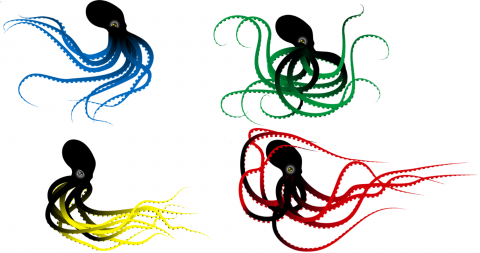
Figure 3: The player character octopus expression has four different response types oblivious (open + positive, upper left), confused (closed + positive, upper right), suspicious (closed + negative, lower left), and aggressive (open + negative, lower right).
In this manner, Mimesis represents two different levels of emotional experience. Open and Closed are external states, since these are highly performative emotional states, and are displayed by the position of the octopus’ tentacles. Positive and Negative, on the other hand, are internal emotional states, displayed using facial expression in a close-up, intimate view with the shape of the octopus’s eye meant to indicate its internal emotional valence, shifting from upturned (positive) to downcast (negative). Each encounter involves a single NPC serving as a salient example of a particular kind of microaggression, as identified by Sue et al. For example, the seahorse conveys the “alien in one’s own land” microaggression theme (although in this case it is “in one’s own sea”).
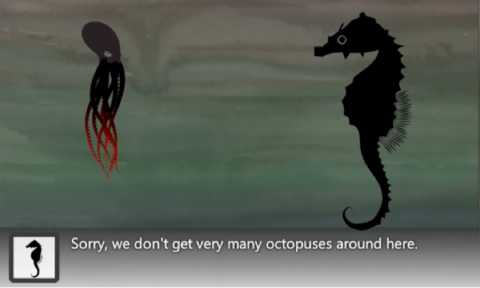
Figure 4: After finally making it to your home region, a seahorse considers you to be an “alien” in your own sea.
In terms of implementation, the game references sets of dialogue annotated with metadata about the response type in order to enact each encounter scenario. These XML-formatted narrative description files contain information about player dialogue, the particular NPC responses that are invoked as a result of player actions, and rules determining how the PC’s emotional state triggers particular responses, and narrative conclusions.
Every encounter concludes with a reflective poetic statement that is different each time based on the trajectory of the player character’s moods over the encounter, e.g., from oblivious to aggressive or just being constantly suspicious.
Endings
The overall ending of the game is also different each time based on the trajectory of the player character’s moods across all of the encounters and the player’s answers to the questionnaire at the start of the game. These endings represent different personal or political responses to microaggression, e.g., one trajectory is that of the assimilationist, another is that of the activist, and so on. Figure 5 presents one possible ending of the game. The sequence of text is presented one line at a time.

Figure 5. The screen shows the concluding coda screen at the end of the playable narrative in Mimesis. The text fades (as depicted above), reflecting upon the dominant response type (Aggressive) employed by the player through the encounters within the game.
In summary, endings are determined based on:
- player modeling (awareness + experience as determined by a questionnaire),
- single encounter interaction emotion trajectories (e.g., oblivious → aggressive, closed → open, always open, etc.), and
- emotional trajectory across all encounters.
Replaying the game with different response types helps players to better understand their experiences. This game design reflects our goal to call attention to the general phenomenon of microaggressions, using evocative metaphor rather than overt rhetoric.
Reflection
With Mimesis, we focused on presenting a metaphorical experience of microaggressions grounded in realistic encounters that one might encounter in everyday life. Deciding upon an appropriate level of metaphor balanced with social realism was one of the central design challenges. In fact, based on our commitment to conveying the game’s central theme, we cut out various features that were developed. For example, an earlier version of the game also adapted the octopus based on how much its responses mimicked the discourse of each sea creature it encountered (see Figure 6).
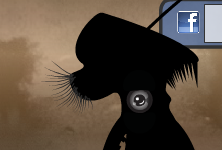
Figure 6: In an earlier version the octopus transformed based on its mimicry of NPC microaggressions, in this case it is becoming more like an anglerfish.
More significantly, however, we developed another technically advanced aspect of the system in order to emphasize the connection of the player character to the real player controlling it. In the end we took what we felt was a bold step by removing this major component of the system in order to streamline the play experience (though fortunately we were able to use the underlying technology in another project). Because this design fork in the road may be a useful account for other developers and because it reveals our aims in more depth, we describe it below.
Design Fork: Integrated Social Networking and Gaming
The additional layer of Mimesis, ultimately cut from the experience, was a feature by which the octopus’s initial emotional state was determined by a player’s real social networking profile. The primary feature of this layer of Mimesis was developed to take advantage of the fact that social networking profiles are aspects of computational identity applications that contain real-world information useful for modeling social identity phenomena.6 In particular, the component used the player’s real-world musical preferences – either those listed on the player’s profile on the popular social network Facebook or using preferences selected in a musical preference interface in Mimesis itself (see Figure 7).
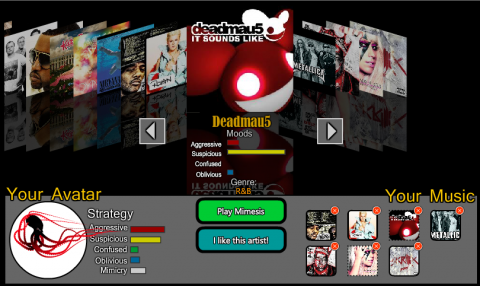
Figure 7. In an earlier version of Mimesis, a user could customize the player character by selecting musical preferences through this interface or using musical preferences (“likes”) expressed in the online social network Facebook.
After reading in a player’s musical preferences, we encapsulated each artist into an entity called a music element, composed of two pieces of meta-data: the moods and the genres associated with the artist (generated by querying the Rovi Cloud Services API). With this element of Mimesis, our aim was not to achieve comprehensive and robust musical classification for its own sake, but rather to use musical taste as a narrow lens on one limited aspect of a player’s real-world identity. Rather than implementing an explicit mapping to avatar appearance, we used this music categorization to limit the emotional possibilities of the player character expressible using the four types of response to microaggressions listed above.
In the end, while conceptually relevant since a major use of music is emotion regulation and prior work has been done on musical mood classification,7 the domain of music added a component that seemed too removed from the “sea creatures are microaggression themes” metaphor we sought to convey. However, we feel that the idea of using a player’s real-world profile to determine a player character or avatar in a game is a strong one and we have since utilized the approach in an interactive narrative called Chimeria: Musical Preferences.8
Another key reflection on Mimesis concerns what we feel was a very successful component – the endings. There is no winning trajectory of responses – there is only a series of trade-offs in a no-win situation. In this manner, some players might consider Mimesis more properly labeled an interactive story rather than a game if winning and losing is necessary to the player’s definition of a game. Rather than designing a game oriented toward winning in which the player picks the best strategy to deal with microaggressions, the user’s actions in Mimesis elicit ambiguous and complex endings that reveal the trade-offs of different response types when dealing with covert discrimination. Instead of win conditions, Mimesis offers an invitation to explore and contemplate the complex structure of a particular subjective experience. In the end, the player’s types of responses are characterized by the system as representing political approaches such as assimilation, bitter or naive activism, or willful ignorance—bleak accounts of the unfortunate fallout of discrimination.
Conclusion
Mimesis is a game with a social agenda that is expressed via evocative metaphor. The undersea metaphor adds a layer of abstraction from everyday life to help call attention to the general phenomenon of microaggression. In this sense, the setting serves as an “empowering phantasm,” defined by Harrell as a blend of conceptual content and mental/sensory imagery designed to engender conceptual and social change (Harrell, Phantasmal Media 16).9 In the case of Mimesis, this is instantiated in a system that helps to catalyze positive changes to people’s perceptions and attitudes regarding this particular form of discrimination.
When we created Mimesis, our aim was to engender player recognition and understanding of many types of microaggressive discrimination by building a system that allowed players to directly experience this phenomenon. Indeed, we have found that replaying Mimesis helps players to better understand both the game itself and the many valences of microaggression by comparing and contrasting the results and subjective experiences of different types of response. Ultimately, we feel that this ability — to directly convey the subjective experiences of discrimination, including those of navigating a social reality rife with identity-based ills — is one of the most powerful and unique affordances of interactive narratives and games. Mimesis is intended to demonstrate that, through a playful coupling of real-world and fictive identity attributes, and a careful attention to the construction of critical metaphor through evocative narrative craft, games can allow players to escape their own narrow subjectivities and experience aspects of what it is like to live with an identity different from their own. It is our hope that by building and refining works such as Mimesis, we can demonstrate a way forward in which games are seen as a crucial medium for promoting the mutual values that support a peaceful and inclusive society.
Acknowledgements
The authors wish to thank the members of Professor Fox Harrell’s course CMS.628/828: Advanced Identity Representation at the Massachusetts Institute of Technology during Fall 2011—Susan Lemont (Harvard), Christine Yu, Andy Kalenderian, Kaichen Ma, Richard Wood, and Justin Sousa—for their help in the brainstorming, design and implementation of Mimesis. This material is based upon work supported by the National Science Foundation under CAREER #0952896 and a National Endowment for the Humanities Digital Humanities Start-Up Grant.
Works Cited
Sue, Derald W., Christina M. Capodilupo, Gina C. Torino, Jennifer M. Bucceri, Aisha M. B. Holder, Kevin L. Nadal, and Marta Esquilin. “Racial Microaggressions in Everyday Life: Implications for Clinical Practice.” American Psychologist 62.4 (2007): 271-286.
Works Consulted
Bowker, Geoffrey C. and Susan Leigh Star. Sorting Things Out: Classification and Its Consequences. Cambridge: MIT Press, 1999.
Goguen, Joseph. “Notes on Narrative. 2001. From http://www.cse.ucsd.edu/~goguen/papers/narr.html.
Greenhow, Christine and Beth Robelia. Informal Learning and Identity Formation in Online Social Networks. Learning, Media and Technology 32.2 (2009): 119-140.
Hargreaves, David J., Dorothy Miell, & Raymond MacDonald. “What are musical identities, and why are they important.” Musical Identities. Oxford: Oxford University Press, 2002. 1-20.
Harrell, D. Fox. “Designing empowering and critical identities in social computing and gaming.” CoDesign 6.4 (2010): 187-206.
---. Toward a Theory of Critical Computing:The Case of Social Identity Representation in Digital Media Applications. CTheory (2010).
---. Phantasmal Media: An Approach to Imagination, Computation, and Expression. Cambridge: MIT Press, 2013.
Harrell, D. Fox, D. Kao, and Chong-U Lim. “Computationally Modeling Narratives of Social Group Membership with the Chimeria System.” Paper presented at the Proceedings of the Workshop on Computational Models of Narrative – a satellite workshop of CogSci 2013: The 35th meeting of the Cognitive Science Society, Berlin, Germany. 2013.
Harrell, D. Fox, D. Kao, Chong-U Lim, J. Lipshin, and A. Sutherland. “Authoring Conversational Narratives in Games with the Chimeria Platform.” Paper presented at the Foundations of Digital Games Conference. 2014.
Labov, William. “The Transformation of Experience in Narrative Syntax.” Language in the Inner City. Philadelphia: University of Pennsylvania Press, 1972. 354-396.
Lakoff, George. Women, Fire, and Dangerous Things. Chicago: University Of Chicago Press, 1990.
Laurier, Cyril, Owen Meyers, Joan Serrá, Martin Blech, Perfecto Herrera, and Xavier Serra. Indexing Music by Mood: Design and Integration of an Automatic Content-Based Annotator. Multimedia Tools and Applications 47.3 (2009): 161-184.
Linde, C. Life Stories: The Creation of Coherence. Oxford: Oxford University Press, 1993.
Solorzano, Daniel, Miguel Ceja, and Tara Yosso. “Critical Race Theory, Racial Microaggressions, and Campus Racial Climate: The Experience of African American College Students.” The Journal of Negro Education 69 (2000): 60-73.
Squire, Kurt. From Content to Context: Videogames as Designed Experience. Educational Researcher 35.8 (2006): 19-29.
Williams, David R., Harold W. Neighbors, and James S. Jackson. “Racial/Ethnic Discrimination and Health: Findings from Community Studies.” American Journal of Public Health 93.2 (2003): 200-208.
Footnotes
-
See Sue et al., 2007; Williams, Neighbors, & Jackson, 2003. ↩
-
See Squire, 2006. ↩
-
See Goguen, 2001; Labov, 1972; Linde, 1993. ↩
-
See Bowker & Star, 1999; Harrell, “Toward,” 2010; Lakoff, 1990. ↩
-
See Sue et al. ↩
-
See Greenhow, 2009; Harrell, “Toward,” 2010. ↩
-
See Hargreaves, Miell, & MacDonald, 2002; Laurier et al., 2009. ↩
-
See Harrell, Kao, & Lim, 2013; Harrell, Kao, Lim, Lipshin, & Sutherland, 2014. ↩
-
See Harrell, “Designing,” 2010. ↩
Cite this essay
Harrell, D. Fox. "Playing Mimesis: Engendering Understanding Via Experience of Social Discrimination with an Interactive Narrative Game" Electronic Book Review, 2 November 2014, https://electronicbookreview.com/publications/playing-mimesis-engendering-understanding-via-experience-of-social-discrimination-with-an-interactive-narrative-game/
